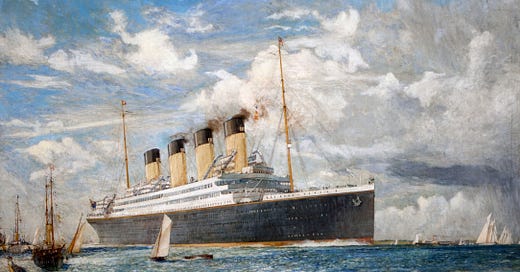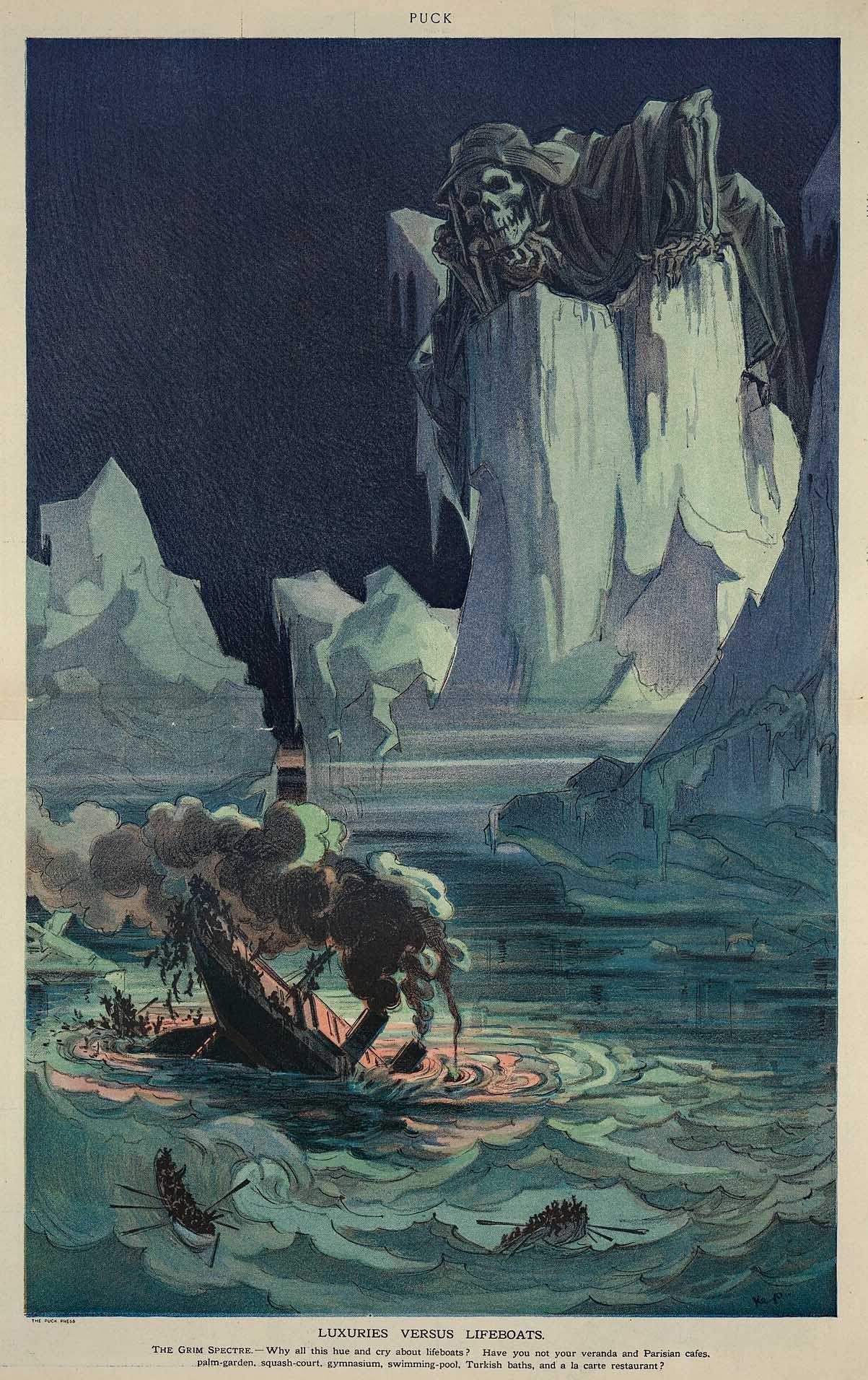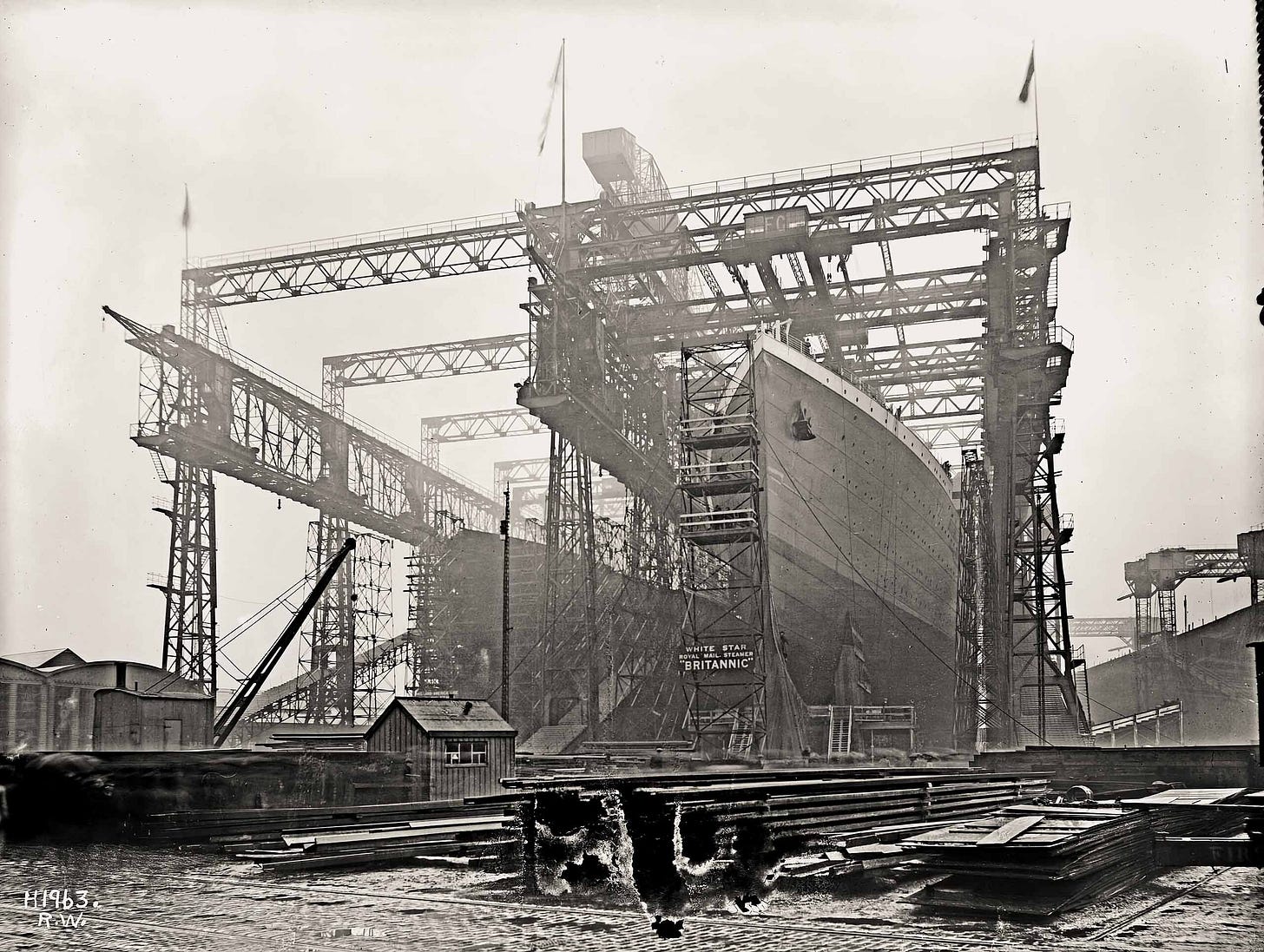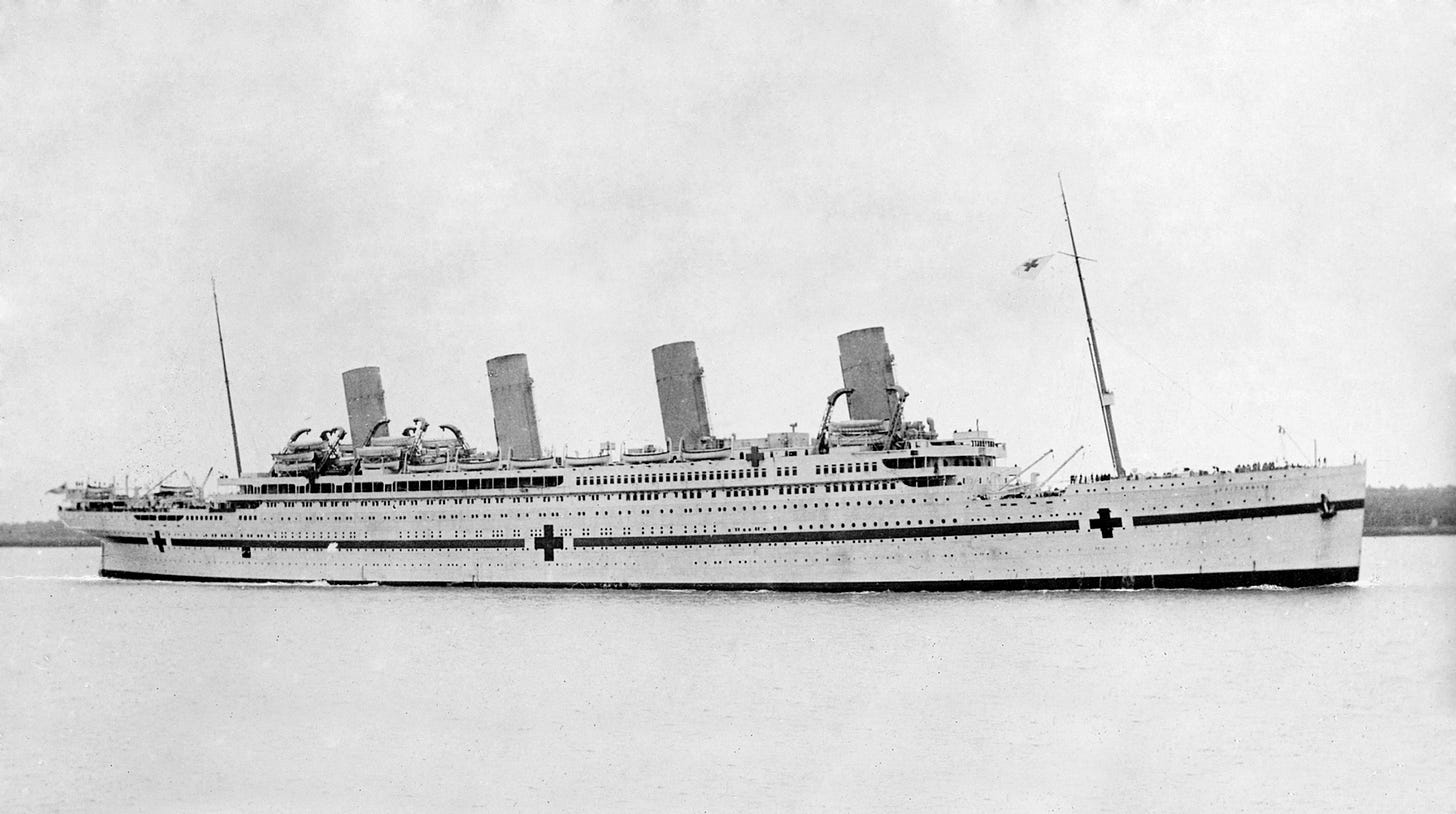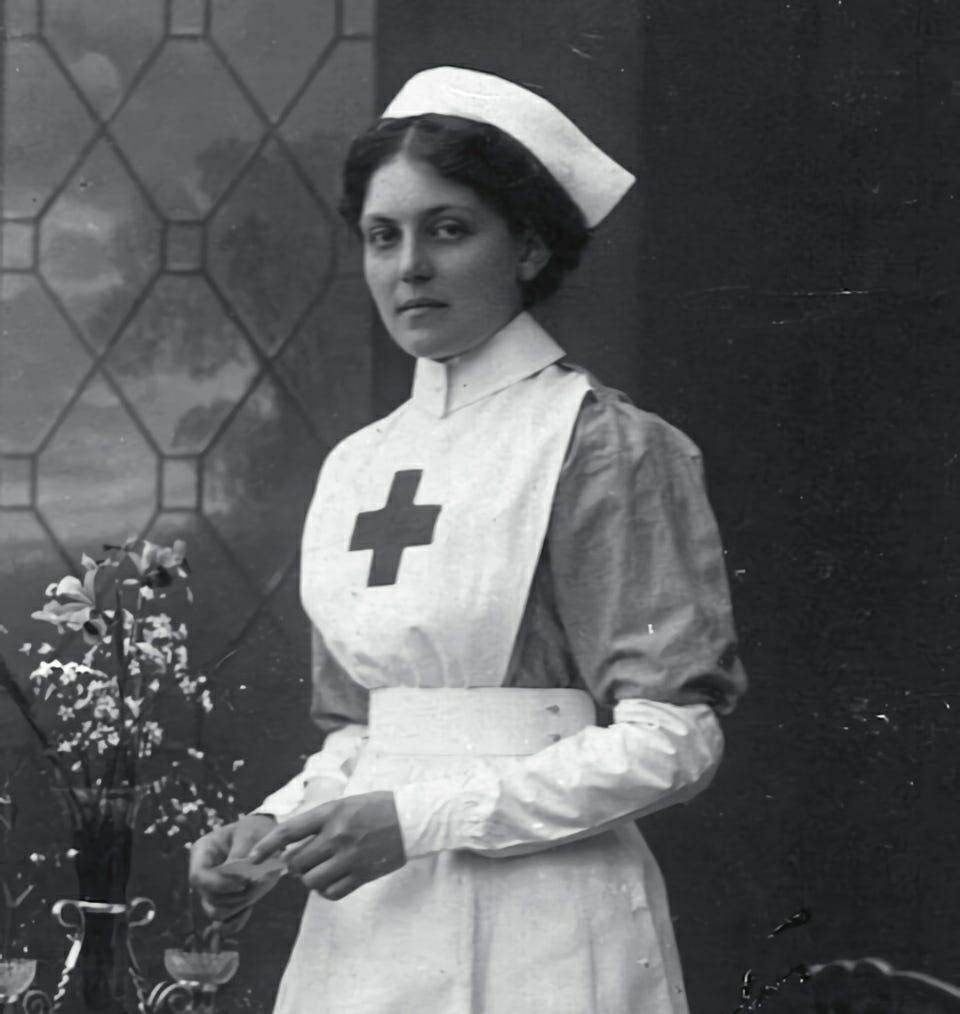The Forgotten Fate of Titanic's Sister Ship
A war-time tragedy that ends not on the bottom of the Atlantic, but the Mediterranean...
Ever since that fateful night in April 1912, the sinking of RMS Titanic has been etched into the world’s collective memory. The story of the disaster has since transformed into an all-encompassing modern myth, rivaling the Greek plays in its power to warn of the sin of hubris.
Yet for the White Star Line, it was but the middle act in a trilogy of tragedies. For in the span of just four years, the famed shipping company saw two of her three most famed liners — each the paragon of luxury in the Edwardian world — find their final resting place at the bottom of the ocean.
The prologue came on 20th September 1911, when the Royal Naval Cruiser HMS Hawke accidentally rammed RMS Olympic off the Isle of Wight. As there were no serious casualties from the collision, the incident instilled a false sense of security in the crew — a complacency which would later prove lethal.
In hindsight, it was also a terrible omen. For Edward Smith, the man who had captained Olympic that day, would just seven months later command Titanic on her first and final voyage.
The third of the White Star Line trio, RMS Britannic, was structurally reinforced in the wake of the disaster that had befallen her sister — but she would not escape her fate. On the 21st November 1916, she struck a naval mine in the Mediterranean, and became the single largest ship of any nation to be sunk in the First World War.
To this day, Britannic remains the largest passenger vessel to be found on the bed of any of the world’s oceans. Her story, though lesser known, is no less dramatic than that of the Titanic. For her sinking, as grisly a tragedy as it was, did far more than just stain the Aegean with blood — it ushered in the end of an era…
The Shadow of Titanic
With the lives of over 1,500 men, women and children lost to the deadly embrace of the North Atlantic, as the world’s most luxurious vessel became their coffin, the fallout of Titanic’s doom was terrible indeed.
The pain of innumerable families torn apart, the staggering loss of property, the mounting legal claims, the spiralling scandal and the need for a convenient villain in so mythic a disaster bore down upon Titanic’s beleaguered owner, the White Star Line, despite outdated international maritime regulations and practices far greater in scope that any single company being the true author of the disaster.
When word of Titanic’s fate reached the Harland & Wolff dockyards of Belfast that had birthed both her and Olympic, in a city whose pride indeed lay in the laying down of ships, the grief that was felt was equalled perhaps only by that of Southampton, home to much of the ship’s fallen crew. Ten members of Harland & Wolff had perished aboard the ship, including the company’s wildly popular managing director and Titanic’s head designer, Thomas Andrews.
Towering ominously above the devastated dockworkers, however, was the skeleton of Titanic’s as yet incomplete younger sister, who was to have eclipsed both of her elders in scale and opulence — the as yet unnamed hull number 433.
As the inquiries on both sides of the Atlantic reached their damning conclusions, and the failures of procedure and design became clear, RMS Olympic was withdrawn from service to be refitted with extensive modifications. 433, however, could be redesigned entirely into what would be the grandest, yet safest, liner yet.
Learning the lessons of Titanic, new head shipbuilder Edward Wilding ensured Britannic was reinforced with a new ‘inner’ skin to give her a double hull, while the watertight bulkheads were greatly raised in height, from D to B Deck. Titanic could have remained floating if four of her watertight compartments were breached. The iceberg alas opened five. 433, therefore, was reinforced to still float with six compromised. Perhaps most symbolically of all however, in light of the 1914 International Convention for the Safety of Life at Sea, the most influential consequence of the sinking of Titanic, 433 would carry 48 lifeboats, enough to bear well in excess of the ship’s capacity of 3,309, and superior davit cranes to manoeuvre them.
Breaking from the tradition of mythological names that had been employed for her older sisters, it was perhaps a mark of the mild moderation of the White Star Line’s ambitions that hull 433 would be named instead for a more earthly power — the British Empire. Thus the new RMS Britannic took form, in a manner that nevertheless exceeded even Titanic in grandeur.
Superior materials were used, the Grand Staircase was entirely redesigned to a new level of ostentation, and almost all first class cabins would be en suite. For Britannic, who was to take over the old mantle of her sister and bear passengers in unrivalled comfort across the Atlantic, a majestic future beckoned.
Events far beyond the confines of Belfast, alas, would deny the realisation of said future when, on the 4th August 1914, the United Kingdom declared war on the German Empire. The Great War had begun…
His Majesty’s Hospital Ship
With the high seas now a war zone, where the danger of German U-boats made the prospect of traversing any open water fearful, RMS Olympic was stood down, while work continued upon Britannic at a vastly reduced pace.
As Christmas 1914 came and went, hopes of a swift victory on the Western Front faded and fears of escalation grew. Instead, a last ditch attempt to force a rapid capitulation came in February 1915, with an attempted decapitation strike against Constantinople to knock the Ottoman Empire out of the war. Following its failure, on the 25th April Allied forces spearheaded by the ANZAC troops of British Oceania attempted to force a landing at Gallipoli, opening one of the costliest and most prolonged military blunders of the entire war.
Exceedingly fierce Turkish resistance exacted a terrible price on the Allies, multiplied by the ravages of typhus and dysentery, to the extent that by the fall of 1915, casualties could not be evacuated swiftly enough. The British government requisitioned two vessels, RMS Mauretania and RMS Aquitania, from the Cunard Line — the White Star Line’s rival — to serve as hospital ships, but even this was not enough. Thus on the 13th November 1915, the White Star Line was mobilised, and RMS Britannic was called up for war.
With great foreboding, the Belfast dockworkers moved rapidly to ready the liner for her grim duty. Amid scenes of heartbreaking symbolism, Britannic’s luxury interiors were torn out, and her hull repainted white in the colours of her new charge. For Royal Mail Steamer she was no more, but His Majesty’s Hospital Ship.
Where First Class passengers were to have dined in splendour, there now stood row after row of beds, wards and operating theatres. On each side of the ship, a thick green line was punctuated by three vast red crosses, with a further two, illuminated by 125 bulbs each, raised on the top deck, in what would prove to be a vain hope to spare her the threat of enemy action.
Thus on the 14th December 1915 was HMHS Britannic, the largest ship yet constructed in the British Isles, assigned to the command of Captain Charles Alfred Bartlett, and staffed not by waiters, sommeliers and stewards, but by 100 nurses, 388 commissioned and non-commissioned officers and a 675-strong body of crew to accompany her into the tides of war…
Into the Maelstrom
Not then New York, but the Greek island of Lemnos would be the destination of Britannic’s maiden mission. Though robbed of her true glamour and colours, her grand and graceful form would charm all those who caught sight of her from Mediterranean shores. To the innocent and the novice, it might almost have seemed a gentle posting aboard the hospital ship.
Yet among the ship’s crew there was one who was no stranger to mortal peril, who long ago had been rendered immune to overconfidence. For the twenty-eight year old Violet Jessop who now donned the nurse’s apron aboard Britannic had worked for the White Star Line before — as stewardess, she had served aboard Olympic the day HMS Hawke had collided with her, and served thereafter aboard Titanic herself, saving a baby as she survived the dramatic sinking.
Alas that she had yet to see her last calamity at sea.
Keep reading with a 7-day free trial
Subscribe to INVICTUS to keep reading this post and get 7 days of free access to the full post archives.

